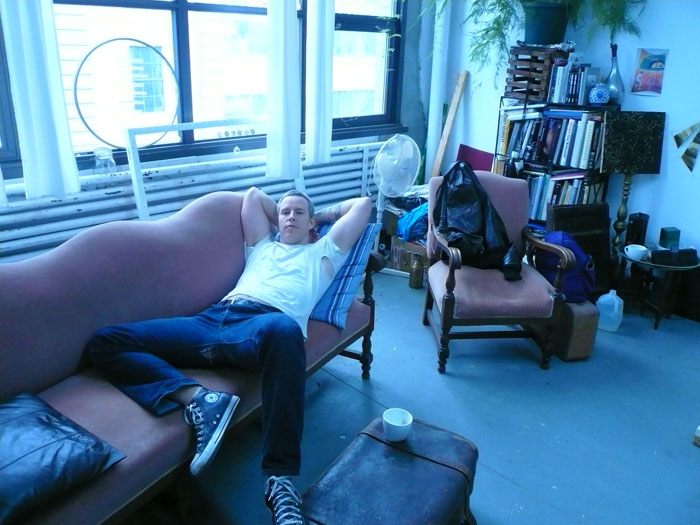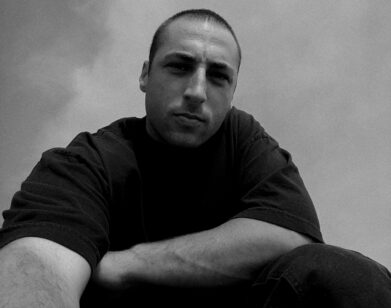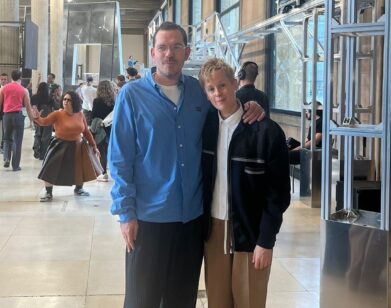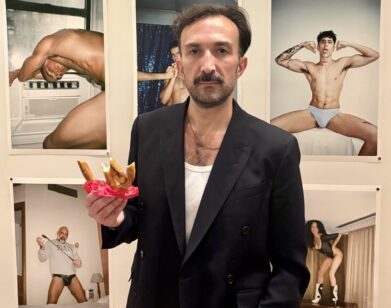Studio Visit: The Magic of Walt Cassidy

PHOTOS BY CHRISTOPHER BOLLEN
Underneath the BQE in the Sunset Park neighborhood of Brooklyn, Walt Cassidy is in his Studio City studio preparing to ship his photographs and sculptures for his solo show, “The Protective Motif,” which opens Friday at Invisible-Exports on the Lower East Side. It’s surprising that this will be Cassidy’s first solo show in New York City, since he’s lived many artistic lives in this town—most famously as Waltpaper, a key club kid of the Michael Alig outrage-as-art early 90s party scene.
But Cassidy’s days at Limelight are over and much of his new work is about escaping those earlier ideas of himself, particularly through an examination of alternate belief systems and the occult. Today he’s got a more sober sense of balance, and his idea of living as an artist doesn’t include the description enfant terrible. Could it be that this is the work of a reasonably happy artist?
Cassidy’s continual use of wheels and circular shapes comes from semi-divine sources. “The shape of orbs that I use are rooted in alchemy,” Cassidy says. “And specifically Milton’s construction of the cosmos in Paradise Lost. Lucifer is the rebel archetype in that story. I was thinking about that archetype and how the rebellious, dark, fallen outsider artist has overwhelmed art from the 1920s to the 1990s. I think we are past that state.”
Cassidy’s work operates symbolically on multiple levels, indicating a level of religious spiritualism and secular cultural resonance while also working as a deeply autobiographical portraits. For five works he plans to show—photographs of abstract sculptural pieces he completed in 2006—he says they are as personal as “a Nan Goldin photograph.” In these photographs, the empty space in a metal frame is woven with aluminum, brass, and copper wire entangling pieces of glass, metal, and specifically sentimental items such as wedding rings from a one-time partner. The circular frame in each photograph is actually a bicycle wheel, which suggests a reflective orb or a mythical wheel, but also the artist’s limited means. “I was making work out of my own apartment so I didn’t have space to store the work I was making. I found that bike rim on the street because I didn’t have a lot of money and I kept photographing what I made on it.”
Since he established his own studio space a year and a half ago, Cassidy found room to create on a larger scale and preserve the results. Lately he’s been working in cut brass, weaving, stripping, and hooking abstract patterns and textures on a wood frame across a black background that read almost as meditation pieces. “I didn’t want to use any more found items,” he says, “because I was looking for materials and shapes that didn’t have energy attached to them already. That way the work could be more my own.” Certainly, the ambitious pieces—minimalist in material but maximalist in emotion—are more about reflection and illumination than in binding or fastening something in. Interestingly, Cassidy’s work also operated where autobiography meets methodology: in the 1970s in Southern California, his father was an industrial psychologist in the days of IQ testing. Cassidy remembers taking the test, which boiled down to arranging shapes in certain formations. “It was about finding a personal logic in abstract emotions,” he says. “And so is this work.”
THE PROTECTIVE MOTIF OPENS APRIL 2, 6–9 PM. INVISIBLE EXPORTS IS LOCATED AT 14A ORCHARD STREET, NEW YORK.






